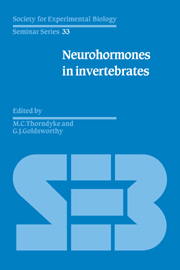Book contents
- Frontmatter
- Contents
- List of contributors
- Preface
- What is special about peptides as neuronal messengers?
- Part I Immunocytochemistry and Ultrastructure
- Part II Arthropod Neurohormones
- Part III Neurohormones in Coelenterates, Annelids and Protochordates
- Part IV Neurohormones in Molluscs
- Bioactive peptides in molluscs
- Actions and roles of the FMRFamide peptides in Helix
- Evolution of peptide hormones: an Aplysia CRF-like peptide
- Index
Evolution of peptide hormones: an Aplysia CRF-like peptide
Published online by Cambridge University Press: 04 August 2010
- Frontmatter
- Contents
- List of contributors
- Preface
- What is special about peptides as neuronal messengers?
- Part I Immunocytochemistry and Ultrastructure
- Part II Arthropod Neurohormones
- Part III Neurohormones in Coelenterates, Annelids and Protochordates
- Part IV Neurohormones in Molluscs
- Bioactive peptides in molluscs
- Actions and roles of the FMRFamide peptides in Helix
- Evolution of peptide hormones: an Aplysia CRF-like peptide
- Index
Summary
Introduction
The discovery that many central neurones utilize peptides as extracellular chemical messengers has revolutionized our understanding of neuronal signalling. Studies to characterize the structure and functions of neuropeptides have taken various approaches, including purification and biochemical analysis of the peptide products and molecular genetic studies of the genes encoding precursor proteins which give rise to peptide products. These investigations have been greatly aided by the use of non-neuronal tissues, such as epithelial tissue or digestive organs, which are often rich sources of bioactive peptides. Many peptides initially identified in peripheral tissues have been found subsequently in the central nervous system. One preparation, frog skin, has been particularly useful in this regard, and has facilitated the discovery of mammalian peptides related to frog bombesin (Orloff et al. 1984).
Invertebrate nervous systems offer unique advantages in the study of neurotransmitter function. Our understanding of the molecular mechanisms underlying neurotransmitter actions have been greatly facilitated by the use of invertebrate systems due to the smaller number of neurons, their simpler organization, and the often large size of their cell soma (see also Chapter 8). In terms of neuropeptide biology and chemistry a number of questions arise: Can neuropeptides related to vertebrate neuropeptides be found in invertebrates? Can neuropeptides characterized in invertebrate systems be used to identify homologous peptides in mammalian systems? Can invertebrate systems be used to gain further insight into the function, regulation, and evolution of neuroendocrine systems?
- Type
- Chapter
- Information
- Neurohormones in Invertebrates , pp. 299 - 310Publisher: Cambridge University PressPrint publication year: 1988
- 4
- Cited by



